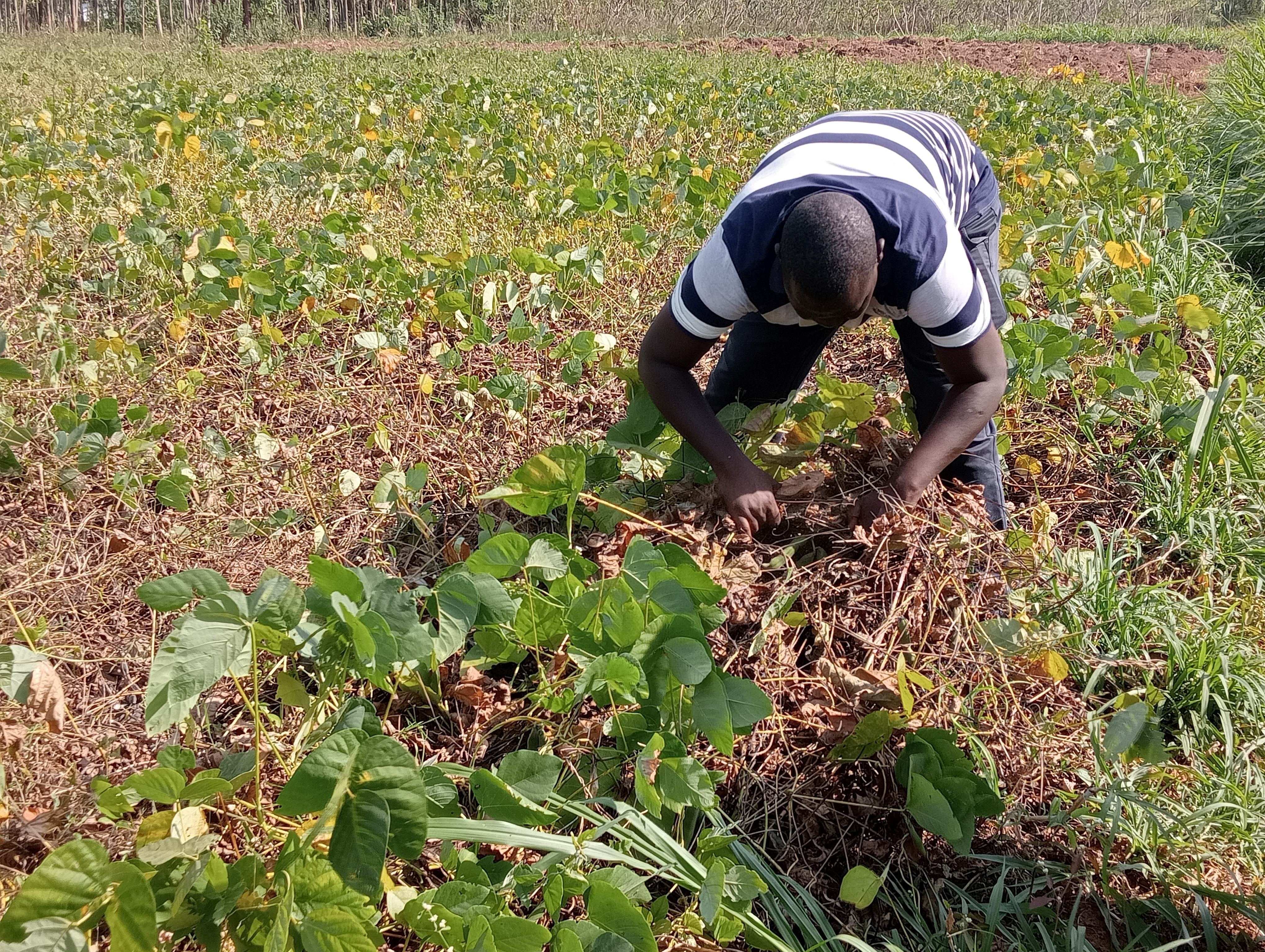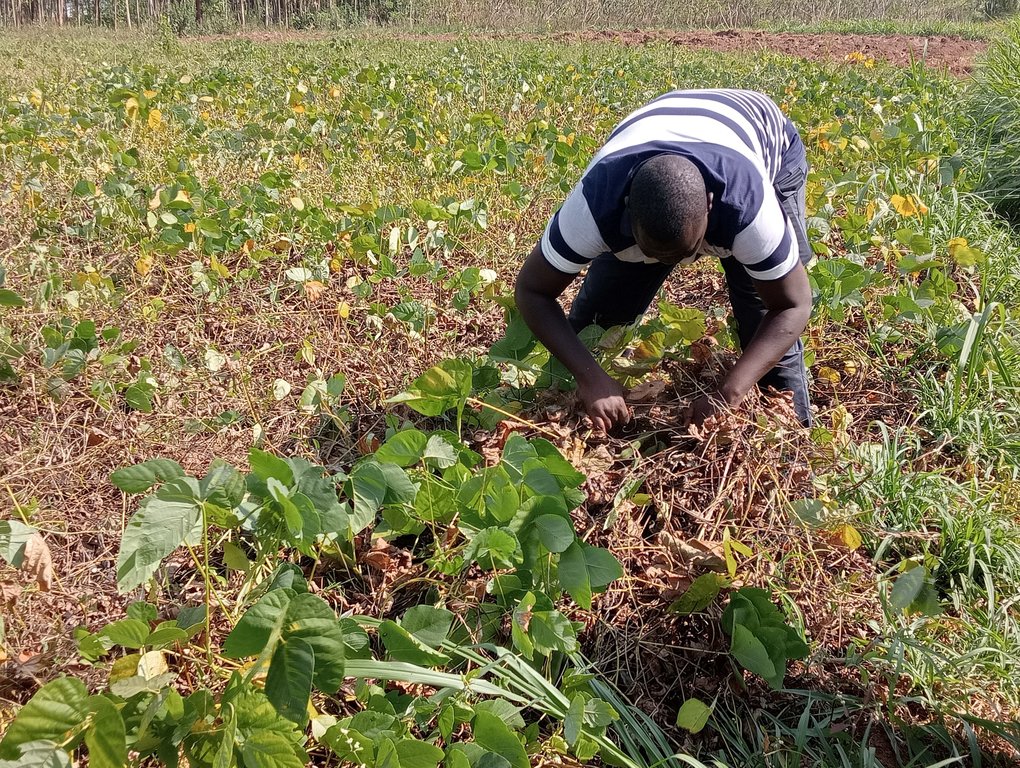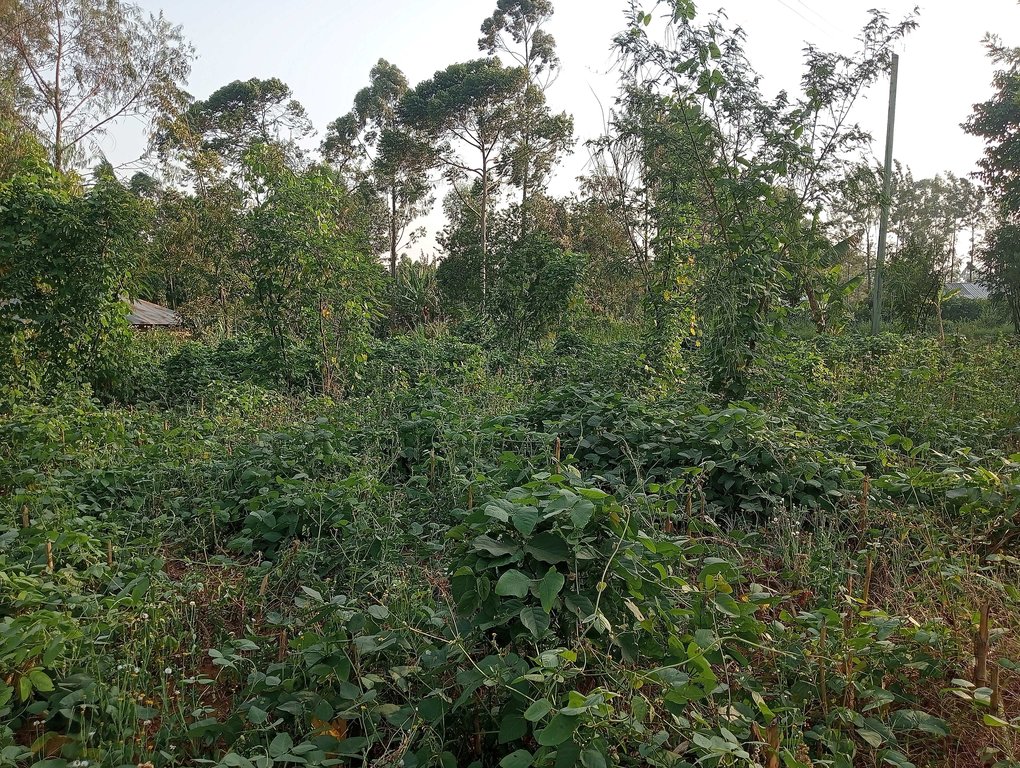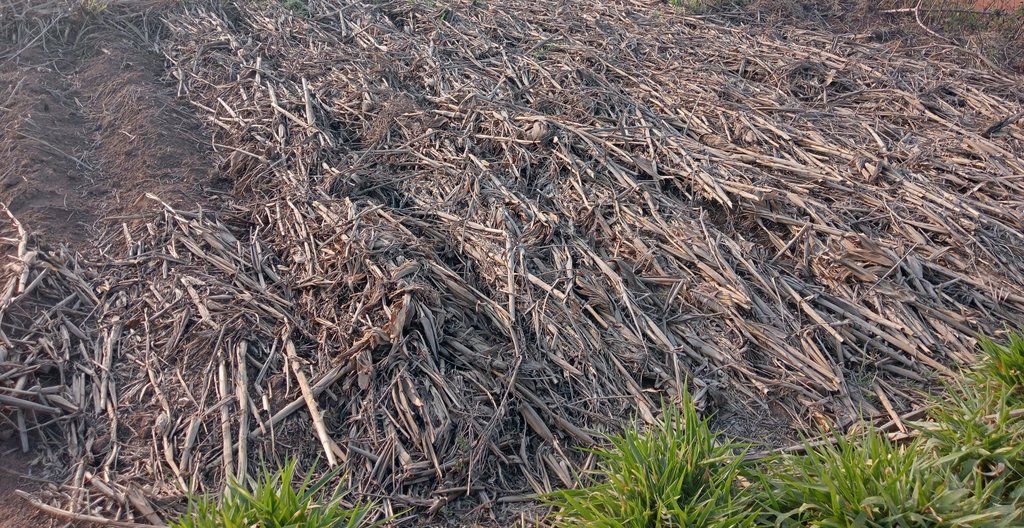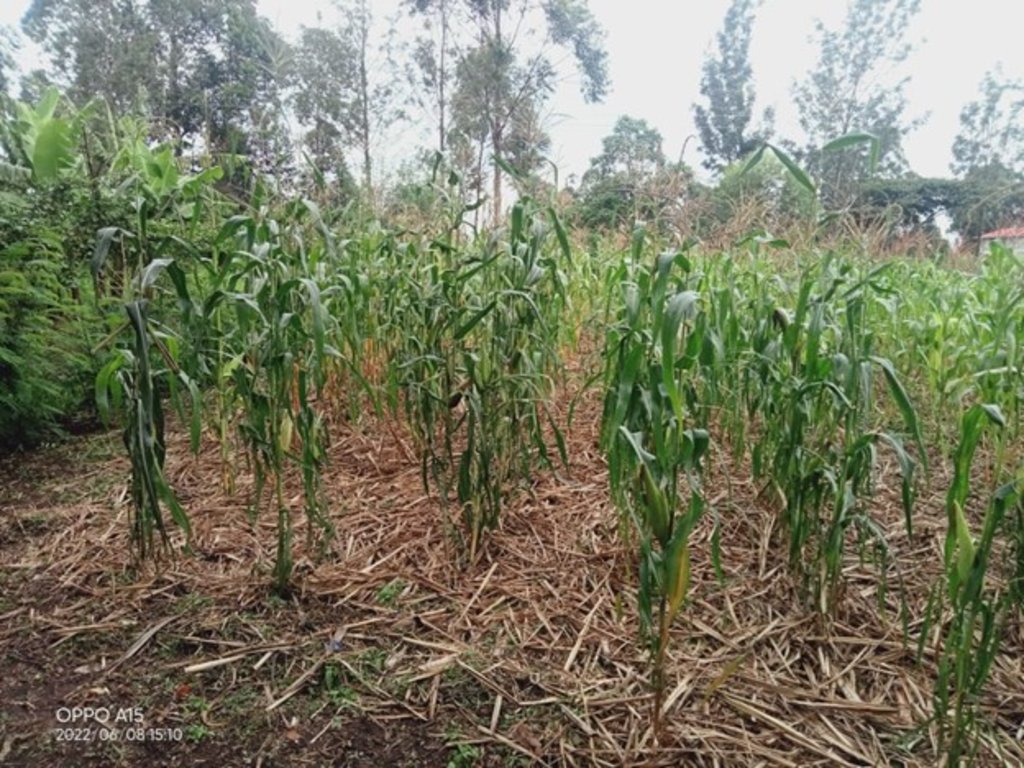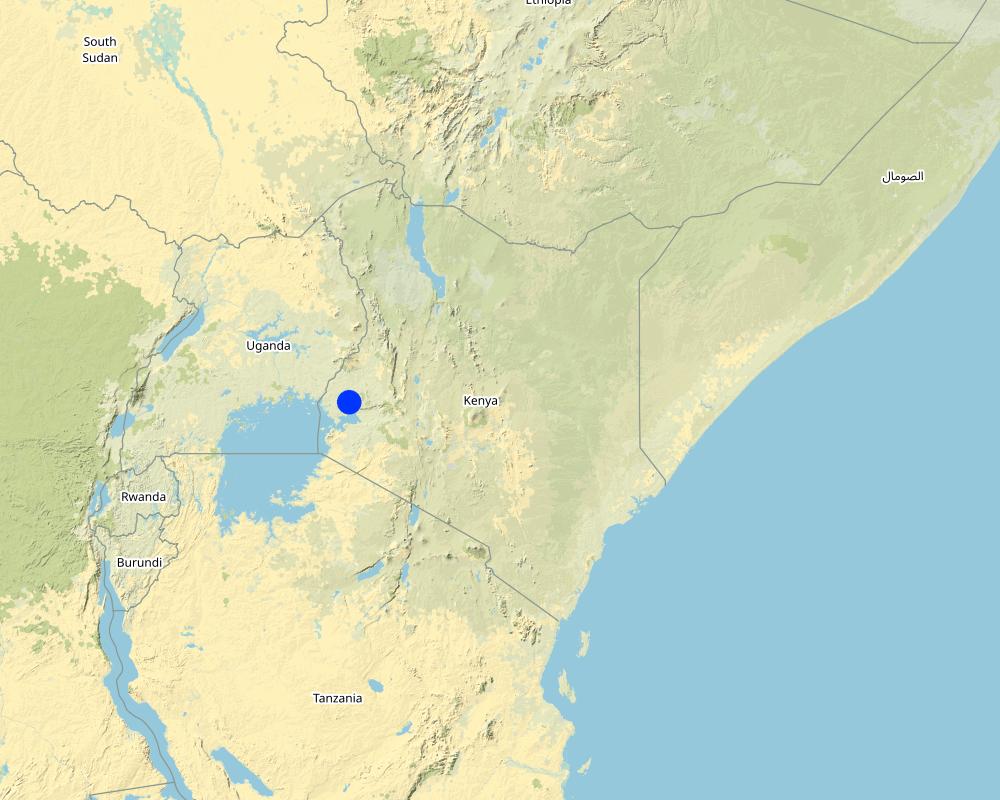Permanent soil cover [Kenya]
- Création :
- Mise à jour :
- Compilateur : William Akwanyi
- Rédacteurs : Innocent Faith, Noel Templer, Leah Munala
- Examinateurs : William Critchley, Rima Mekdaschi Studer
technologies_6699 - Kenya
Voir les sections
Développer tout Réduire tout1. Informations générales
1.2 Coordonnées des personnes-ressources et des institutions impliquées dans l'évaluation et la documentation de la Technologie
Personne(s)-ressource(s) clé(s)
exploitant des terres:
Onjili Jared Kochwa
GFA farmer
Kenya
Spécialiste GDT:
Spécialiste GDT:
Nom du projet qui a facilité la documentation/ l'évaluation de la Technologie (si pertinent)
Soil protection and rehabilitation for food security (ProSo(i)l)Nom du ou des institutions qui ont facilité la documentation/ l'évaluation de la Technologie (si pertinent)
Deutsche Gesellschaft für Internationale Zusammenarbeit (GIZ)Nom du ou des institutions qui ont facilité la documentation/ l'évaluation de la Technologie (si pertinent)
Alliance Bioversity and International Center for Tropical Agriculture (Alliance Bioversity-CIAT) - Kenya1.3 Conditions relatives à l'utilisation par WOCAT des données documentées
Le compilateur et la(les) personne(s) ressource(s) acceptent les conditions relatives à l'utilisation par WOCAT des données documentées:
Oui
1.4 Déclaration sur la durabilité de la Technologie décrite
Est-ce que la Technologie décrite ici pose problème par rapport à la dégradation des terres, de telle sorte qu'elle ne peut pas être déclarée comme étant une technologie de gestion durable des terres?
Non
Commentaires:
Farmers who have implemented the technology have recorded an increase in crop production. The technology has not adversely affected their farms.
1.5 Référence au(x) Questionnaires sur les Approches de GDT (documentées au moyen de WOCAT)
2. Description de la Technologie de GDT
2.1 Courte description de la Technologie
Définition de la Technologie:
Permanent soil cover with cover crops and/or crop residues helps to control soil erosion, suppress weeds and build up soil fertility. It can also add organic matter to the soil.
2.2 Description détaillée de la Technologie
Description:
Permanent soil cover is having all-year-round cover on the soil. This can be either in the form of cover crops which are either planted with other crops at the same time, or relay planted later in the season after the main crops have established, or in the form of crop residues (mulch) which is naturally decomposed by microbes. Permanent soil cover provides a shield or umbrella to the soil protecting it from the heat of the sun and the impact of rain. It makes up a fundamental component of conservation agriculture where minimum tillage reduces soil disturbance.
Some of the crops used for permanent soil cover [those promoted by the ProSoil project] include Mucuna pruriens (velvet bean), Canavalia ensiformis, Dolichos lablab, and Desmodium intortum. All of these are legumes, which fix nitrogen from the atmosphere, thus improving soil fertility. In choosing a cover crop, farmers prefer those that fit into their normal cropping systems, and which have multiple purposes, including those that produce edible seeds and vegetables, those that improve soil fertility, those that can be used as animal fodder, and those that can suppress weeds. Some farmers prefer crops that can provide firewood or fencing material and those that can be used for medicinal purposes. Another important factor that farmers consider when choosing a cover crop is the amount and type of work that the cover crop will need, for example for land preparation before planting, weeding, and producing and harvesting the seeds. The crops most preferred are those that cover the soil quickly and completely, and which can also be used for food and fodder, including mucuna. Farmers also like mucuna because of its big pods and grains that are easier to deal with. Farmers can easily multiply mucuna seeds since they do not require complicated treatments; hence, do not need to continue spending money on the seeds.
In establishing a permanent soil cover using cover crops, farmers first intercrop seasonal crops (e.g., maize and beans) and later introduce a green manure cover crop (e.g., mucuna) after about 6 weeks (or at the time when the beans start to produce pods) to ensure that the green manure cover crop does not suppress the main crop(s). The maize is planted at 75 cm row spacing and 25 cm between plants in the same row. However, within each row, the third hole/ space is left for the cover crop (i.e., mucuna). Thus, mucuna is planted after every three maize plants in the same row. The bean intercrop is planted between the maize rows at the spacing of 37.5 cm from the maize row and 20 cm between bean plants in the same row. This spacing requires about 5 kg of cover crop (mucuna) seeds per acre. The crops continue to grow together and upon harvesting the main crops, the cover crop continues to grow on the farm covering the soil until the following cropping season.
Permanent soil cover is beneficial in the farm in various ways including, enhancing soil water infiltration, protecting soil from agents of erosion, increasing soil organic matter, suppressing weeds, aiding in nutrient cycling, and improving the habitat of soil micro- and macro-organisms. Maintaining permanent soil cover through mulching faces some limitations, including competing uses of crop residues e.g., as animal feeds and fuel. Similarly, drought may be a major limitation to maintaining permanent soil cover using cover crops, especially in areas that receive very low rainfall and where the farmer has not invested in irrigation.
2.3 Photos de la Technologie
Remarques générales concernant les photos:
Permanent soil cover can be achieved using either green manure cover crops or mulch.
2.5 Pays/ région/ lieux où la Technologie a été appliquée et qui sont couverts par cette évaluation
Pays:
Kenya
Région/ Etat/ Province:
Kakamega County in western Kenya
Autres spécifications du lieu:
Kisa Central Ward in Khwisero Sub-county; and Koyonzo and Khalaba wards in Matungu Sub-county
Spécifiez la diffusion de la Technologie:
- répartie uniformément sur une zone
Est-ce que les sites dans lesquels la Technologie est appliquée sont situés dans des zones protégées en permanence?
Non
Commentaires:
There are no protected areas in the areas covered by this assessment. The indicated area is the total for the three farms which were used in the documentation. Most of the information was collected from the farm in Khwisero Sub-county. Some photos were taken from the two farms in Matungu Sub-county.
Map
×2.6 Date de mise en œuvre de la Technologie
Indiquez l'année de mise en œuvre:
2021
2.7 Introduction de la Technologie
Spécifiez comment la Technologie a été introduite: :
- dans le cadre d'un système traditionnel (> 50 ans)
- par le biais de projets/ d'interventions extérieures
Commentaires (type de projet, etc.) :
The farmers were already growing cover crops such as sweet potatoes and pumpkins. The ProSoil project introduced the farmers to other soil cover crops such as mucuna and desmodium.
3. Classification de la Technologie de GDT
3.1 Principal(aux) objectif(s) de la Technologie
- améliorer la production
- réduire, prévenir, restaurer les terres dégradées
- préserver l'écosystème
- conserver/ améliorer la biodiversité
- s'adapter au changement et aux extrêmes climatiques et à leurs impacts
3.2 Type(s) actuel(s) d'utilisation des terres, là où la Technologie est appliquée
Les divers types d'utilisation des terres au sein du même unité de terrain: :
Oui
Précisez l'utilisation mixte des terres (cultures/ pâturages/ arbres):
- Agro-sylvo-pastoralisme

Terres cultivées
- Cultures annuelles
- Cultures pérennes (non ligneuses)
- Plantations d’arbres ou de buissons
Cultures annuelles - Précisez les cultures:
- céréales - maïs
- cultures fourragères - graminées
- cultures fourragères - autres
- légumineuses et légumes secs - fèves
- légumes - melon, citrouille, courge ou cucurbitacées
- légumes - autres
Système de cultures annuelles :
Maïs/sorgho/mil en culture intercalaire avec des légumineuses
Cultures pérennes (non ligneuses) - Précisez les cultures:
- bananier/plantain/abaca
- cultures fourragères - graminées
- fodder crops - legumes, clover
Plantations d'arbres et d'arbustes - Précisez les cultures:
- avocat
- arbres fourragers (Barbe jolote, Faux mimosa, Prosopis, etc.)
- fruits, autres
- manguier, mangostane, goyave
- papaye
Nombre de période de croissance par an: :
- 2
Précisez:
Crops are grown during the long and short rain seasons.
Est-ce que les cultures intercalaires sont pratiquées?
Oui
Si oui, précisez quelles cultures sont produites en culture intercalaire:
Maize and legumes (beans)
Est-ce que la rotation des cultures est appliquée?
Oui
Si oui, veuillez préciser:
Mucuna is left to continue covering the soil after the main crop(s) has/ have been harvested.

Pâturages
Pâturage intensif/ production fourragère :
- Affouragement en vert/ zéro-pâturage
- Prairies améliorées
Type d'animal:
- bétail - laitier
- cattle - dairy and beef (e.g. zebu)
- volailles
Est-ce que la gestion intégrée cultures-élevage est pratiquée?
Oui
Si oui, veuillez préciser:
Manure from livestock is applied to the crop fields.
Produits et services:
- economic security, investment prestige
- oeufs
- manure as fertilizer/ energy production
- viande
- lait
Espèces:
bétail - laitier
Nombre:
1
Espèces:
cattle - dairy and beef (e.g. zebu)
Nombre:
2
Espèces:
volailles
Nombre:
20
3.3 Est-ce que l’utilisation des terres a changé en raison de la mise en œuvre de la Technologie ?
Est-ce que l’utilisation des terres a changé en raison de la mise en œuvre de la Technologie ?
- Non (Passez à la question 3.4)
3.4 Approvisionnement en eau
Approvisionnement en eau des terres sur lesquelles est appliquée la Technologie:
- pluvial
Commentaires:
Crop establishment is dependent on availability of rainfall.
3.5 Groupe de GDT auquel appartient la Technologie
- Amélioration de la couverture végétale/ du sol
- perturbation minimale du sol
- gestion intégrée de la fertilité des sols
3.6 Mesures de GDT constituant la Technologie

pratiques agronomiques
- A1: Couverture végétale/ du sol
- A2: Matière organique/ fertilité du sol
- A3: Traitement de la couche superficielle du sol
- A6: Gestion des résidus des cultures
A3: Différenciez les systèmes de travail du sol:
A 3.1: Systèmes de culture sans travail du sol
A6: Précisez la gestion des résidus des cultures:
A 6.5: Résidus retenus
Commentaires:
Permanent soil cover is normally associated with reduced or zero tillage.
3.7 Principaux types de dégradation des terres traités par la Technologie

érosion hydrique des sols
- Wt: perte de la couche superficielle des sols (couche arable)/ érosion de surface

érosion éolienne des sols
- Et: perte de la couche superficielle des sols (couche arable)

dégradation chimique des sols
- Cn: baisse de la fertilité des sols et réduction du niveau de matière organique (non causée par l’érosion)

dégradation physique des sols
- Pc: compaction

dégradation biologique
- Bc: réduction de la couverture végétale
- Bs: baisse de la qualité et de la composition/ diversité des espèces

dégradation hydrique
- Ha: aridification
3.8 Prévention, réduction de la dégradation ou réhabilitation des terres dégradées
Spécifiez l'objectif de la Technologie au regard de la dégradation des terres:
- prévenir la dégradation des terres
- s'adapter à la dégradation des terres
4. Spécifications techniques, activités, intrants et coûts de mise en œuvre
4.1 Dessin technique de la Technologie
Spécifications techniques (associées au dessin technique):
Maize/ mucuna spacing: row to row = 75 cm, plant to plant in the same row = 25 cm, mucuna planted in every third hole/ space in the same row
Bean spacing: bean rows between the maize/ mucuna rows, bean row to maize/ mucuna row = 37.5 cm, plant to plant in the same row = 20 cm
Auteur:
William Akwanyi
Date:
04/07/2023
4.2 Informations générales sur le calcul des intrants et des coûts
Spécifiez la manière dont les coûts et les intrants ont été calculés:
- par superficie de la Technologie
Indiquez la taille et l'unité de surface:
1 acre
autre/ monnaie nationale (précisez):
KES
Indiquez le taux de change des USD en devise locale, le cas échéant (p.ex. 1 USD = 79.9 réal brésilien): 1 USD = :
124,21
Indiquez le coût salarial moyen de la main d'œuvre par jour:
KES 250.00
4.3 Activités de mise en place/ d'établissement
Commentaires:
Land preparation in a conservation agriculture situation will only involve mowing and sub-soiling that are less costly than plouging.
4.5 Activités d'entretien/ récurrentes
| Activité | Calendrier/ fréquence | |
|---|---|---|
| 1. | Land preparation | Before rains |
| 2. | Planting | After rains |
| 3. | Shallow weeding | During the second weeding of the main crop at 1.5 months |
| 4. | Uncoiling (e.g., mucuna from the main crop) | Bi-weekly |
4.6 Coûts et intrants nécessaires aux activités d'entretien/ récurrentes (par an)
| Spécifiez les intrants | Unité | Quantité | Coûts par unité | Coût total par intrant | % des coût supporté par les exploitants des terres | |
|---|---|---|---|---|---|---|
| Main d'œuvre | Slashing | Man-days | 5,0 | 250,0 | 1250,0 | 100,0 |
| Main d'œuvre | Sub-soiling | Man-days | 10,0 | 250,0 | 2500,0 | 100,0 |
| Main d'œuvre | Planting | Man-days | 4,0 | 250,0 | 1000,0 | 100,0 |
| Main d'œuvre | Shallow weeding and uncoiling (e.g., mucuna from the main crop) | Man-days | 9,0 | 250,0 | 2250,0 | 100,0 |
| Equipements | Slasher | No. | 1,0 | 70,0 | 70,0 | |
| Equipements | Hand-held sub-soiler | No. | 1,0 | 70,0 | 70,0 | |
| Equipements | Jab planter | No. | 1,0 | 1000,0 | 1000,0 | |
| Equipements | Shallow weeder | No. | 1,0 | 80,0 | 80,0 | |
| Matériel végétal | Cover crop seeds | Kgs | 5,0 | 150,0 | 750,0 | |
| Coût total d'entretien de la Technologie | 8970,0 | |||||
| Coût total d'entretien de la Technologie en dollars américains (USD) | 72,22 | |||||
Si le coût n'est pas pris en charge à 100% par l'exploitant des terres, indiquez qui a financé le coût restant:
ProSoil through GFA
Commentaires:
The farmer does not need fertilizer and manure for planting mucuna. The ProSoil project through Welthungerhilfe provided slashers, hand-held sub-soilers, and jab planters to the farmers through their groups. The costs of these implements are KES 350/- for a slasher, KES 350/- for a hand-held sub-soiler, KES 400/- for a shallow weeder, and KES 5,000/- for a jab planter. It is assumed that the farmer will be able to use these implements over a period of 5 years before these implements will have depreciated to a point where they will not be useable. The cost is thus spread over the years when the farmer will be able to use the implement. The total time required for uncoiling is about 5 man-days for the entire duration of the growth of the main crop(s) in a season and the total time required for shallow weeding is about 4 man-days.
4.7 Facteurs les plus importants affectant les coûts
Décrivez les facteurs les plus importants affectant les coûts :
Rate of man-days vary from one place to another, farmer to farmer, and with type of work.
Exchange rate for February 2023, source: European Commission/ InfoEuro online at https://commission.europa.eu/funding-tenders/procedures-guidelines-tenders/information-contractors-and-beneficiaries/exchange-rate-inforeuro_en
5. Environnement naturel et humain
5.1 Climat
Précipitations annuelles
- < 250 mm
- 251-500 mm
- 501-750 mm
- 751-1000 mm
- 1001-1500 mm
- 1501-2000 mm
- 2001-3000 mm
- 3001-4000 mm
- > 4000 mm
Spécifiez la pluviométrie moyenne annuelle (si connue), en mm:
1300,00
Spécifications/ commentaires sur les précipitations:
Monthly rainfall variability is high with some months such as January recording less than 5 mm of total rainfall.
Indiquez le nom de la station météorologique de référence considérée:
Kakamega Meteorological Station
Zone agro-climatique
- humide
The climate in the area favours most agricultural activities.
5.2 Topographie
Pentes moyennes:
- plat (0-2 %)
- faible (3-5%)
- modéré (6-10%)
- onduleux (11-15%)
- vallonné (16-30%)
- raide (31-60%)
- très raide (>60%)
Reliefs:
- plateaux/ plaines
- crêtes
- flancs/ pentes de montagne
- flancs/ pentes de colline
- piémonts/ glacis (bas de pente)
- fonds de vallée/bas-fonds
Zones altitudinales:
- 0-100 m
- 101-500 m
- 501-1000 m
- 1001-1500 m
- 1501-2000 m
- 2001-2500 m
- 2501-3000 m
- 3001-4000 m
- > 4000 m
Indiquez si la Technologie est spécifiquement appliquée dans des:
- non pertinent
Commentaires et précisions supplémentaires sur la topographie:
The farm is located at an area that is higher in altitude compared to other areas in the larger area. The altitude at the farm is 1,416 m above sea level.
5.3 Sols
Profondeur moyenne du sol:
- très superficiel (0-20 cm)
- superficiel (21-50 cm)
- modérément profond (51-80 cm)
- profond (81-120 cm)
- très profond (>120 cm)
Texture du sol (de la couche arable):
- moyen (limoneux)
Texture du sol (> 20 cm sous la surface):
- moyen (limoneux)
Matière organique de la couche arable:
- moyen (1-3%)
Si disponible, joignez une description complète du sol ou précisez les informations disponibles, par ex., type de sol, pH/ acidité du sol, capacité d'échange cationique, azote, salinité, etc.
Soil pH of most farms in the area ranges from moderately acid (5.50) to moderately alkaline (7.80).
5.4 Disponibilité et qualité de l'eau
Profondeur estimée de l’eau dans le sol:
5-50 m
Disponibilité de l’eau de surface:
bonne
Qualité de l’eau (non traitée):
eau potable
La qualité de l'eau fait référence à:
à la fois les eaux souterraines et de surface
La salinité de l'eau est-elle un problème? :
Non
La zone est-elle inondée?
Non
Commentaires et précisions supplémentaires sur la qualité et la quantité d'eau:
There are several boreholes in the area and according to interviews with some borehole owners, the depts are not more than 50 metres.
5.5 Biodiversité
Diversité des espèces:
- moyenne
Diversité des habitats:
- moyenne
Commentaires et précisions supplémentaires sur la biodiversité:
The area has high agrobiodiversity since most farms are under crops and trees.
5.6 Caractéristiques des exploitants des terres appliquant la Technologie
Sédentaire ou nomade:
- Semi-nomade
Orientation du système de production:
- exploitation mixte (de subsistance/ commerciale)
Revenus hors exploitation:
- > 50% de tous les revenus
Niveau relatif de richesse:
- moyen
Individus ou groupes:
- individu/ ménage
Niveau de mécanisation:
- travail manuel
Genre:
- femmes
- hommes
Age des exploitants des terres:
- personnes d'âge moyen
5.7 Superficie moyenne des terres utilisées par les exploitants des terres appliquant la Technologie
- < 0,5 ha
- 0,5-1 ha
- 1-2 ha
- 2-5 ha
- 5-15 ha
- 15-50 ha
- 50-100 ha
- 100-500 ha
- 500-1 000 ha
- 1 000-10 000 ha
- > 10 000 ha
Cette superficie est-elle considérée comme de petite, moyenne ou grande dimension (en se référant au contexte local)?
- moyenne dimension
5.8 Propriété foncière, droits d’utilisation des terres et de l'eau
Propriété foncière:
- individu, sans titre de propriété
- individu, avec titre de propriété
Droits d’utilisation des terres:
- loué
- individuel
Droits d’utilisation de l’eau:
- accès libre (non organisé)
Est-ce que les droits d'utilisation des terres sont fondés sur un système juridique traditionnel?
Non
Commentaires:
The farmer has an official title deed for his piece of land. He also leases other people's pieces of land for farming. Water in the streams and springs is freely accessed without restrictions.
5.9 Accès aux services et aux infrastructures
santé:
- pauvre
- modéré
- bonne
éducation:
- pauvre
- modéré
- bonne
assistance technique:
- pauvre
- modéré
- bonne
emploi (par ex. hors exploitation):
- pauvre
- modéré
- bonne
marchés:
- pauvre
- modéré
- bonne
énergie:
- pauvre
- modéré
- bonne
routes et transports:
- pauvre
- modéré
- bonne
services financiers:
- pauvre
- modéré
- bonne
Commentaires:
The above rating varies from one village to the other.
6. Impacts et conclusions
6.1 Impacts sur site que la Technologie a montrés
Impacts socio-économiques
Production
production agricole
Quantité avant la GDT:
Less than 3
Quantité après la GDT:
More than 7
Commentaires/ spécifiez:
Quantity refers to the number of 90 Kg bags of maize produced per acre. Based on the farmer's estimate.
qualité des cultures
Commentaires/ spécifiez:
Not easy to quantify. The crops do better compared to how they could do in the past, yet he does not use inorganic fertilizers. Based on the farmer's estimate.
production fourragère
Quantité avant la GDT:
2
Quantité après la GDT:
5
Commentaires/ spécifiez:
Quantity refers to harvesting cycles per year for nappier grass from the same farm. Based on the farmer's estimate.
qualité des fourrages
Commentaires/ spécifiez:
Not easy to quantify. Fodder does better compared to how it was before the technology. Based on the farmer's estimate.
production animale
Quantité avant la GDT:
2
Quantité après la GDT:
5
Commentaires/ spécifiez:
Quantity refers to the amount of milk in litres from one cow. Based on the farmer's estimate.
risque d'échec de la production
Quantité avant la GDT:
70
Quantité après la GDT:
40
Commentaires/ spécifiez:
Quantity refers to the percentage probability of the crop failing to do well. Based on the farmer's estimate.
gestion des terres
Commentaires/ spécifiez:
Not easy to quantify but it is easier to prepare land through no tillage than to plough.
Revenus et coûts
dépenses pour les intrants agricoles
Quantité avant la GDT:
10,000
Quantité après la GDT:
0
Commentaires/ spécifiez:
Quantity refers to the amount of money in Kenya shillings spend on inorganic fertilizers in a season. The farmer no longer buys money inorganic fertilizers. Based on the farmer's experience.
revenus agricoles
Quantité avant la GDT:
500
Quantité après la GDT:
10000
Commentaires/ spécifiez:
Quantity refers to the amount of money in Kenya shillings received from the sale of farm produce in a year.
diversité des sources de revenus
Quantité avant la GDT:
2
Quantité après la GDT:
3
Commentaires/ spécifiez:
Quantity refers to the number of household income sources.
charge de travail
Commentaires/ spécifiez:
Not easy to quantify but it is easier to prepare land through no tillage than to plough.
Impacts socioculturels
sécurité alimentaire/ autosuffisance
Quantité avant la GDT:
3
Quantité après la GDT:
1
Commentaires/ spécifiez:
Quantity refers to the number of months in a year when there is total lack of food in the house, and the farmer has to buy all the food required in the house. Based on the farmer's estimate.
connaissances sur la GDT/ dégradation des terres
Commentaires/ spécifiez:
Refers to the estimated percentage of knowledge in SLM/ land management. Based on the farmer's estimate. His knowledge in SLM has greatly increased.
Impacts écologiques
Sols
humidité du sol
Commentaires/ spécifiez:
Refers to the farmer's estimated soil moisture content during the dry season when soil moisture challenges are expected to be high.
couverture du sol
Quantité avant la GDT:
40
Quantité après la GDT:
60
Commentaires/ spécifiez:
Quantity refers to the farmer's estimated percentage soil cover at the farm.
perte en sol
Commentaires/ spécifiez:
Not easy for the farmer to quantify. According to him, soil erosion has reduced.
accumulation de sol
Commentaires/ spécifiez:
Not easy for the farmer to quantify. Based on the farmer's estimate.
cycle/ recharge des éléments nutritifs
Commentaires/ spécifiez:
Not easy for the farmer to quantify. Based on the farmer's estimate.
matière organique du sol/ au dessous du sol C
Commentaires/ spécifiez:
Not easy to quantify as there is no data. Based on the farmer's estimate.
Biodiversité: végétale, animale
Couverture végétale
Quantité avant la GDT:
30
Quantité après la GDT:
60
Commentaires/ spécifiez:
Quantity refers to the farmer's estimated percentage vegetation cover at the farm.
biomasse/ au dessus du sol C
Commentaires/ spécifiez:
Not easy for the farmer to quantify. Based on the farmer's estimate.
diversité végétale
Quantité avant la GDT:
4
Quantité après la GDT:
11
Commentaires/ spécifiez:
Quantity refers to the number of plants (crops) that the farmer establishes at the farm. Based on the farmer's estimate.
espèces étrangères envahissantes
Quantité avant la GDT:
6
Quantité après la GDT:
4
Commentaires/ spécifiez:
Quality refers to the number of species of weeds and invasive plants at the farm. Based on the farmer's estimate.
diversité des habitats
Commentaires/ spécifiez:
Not easy for the farmer to quantify. Based on the farmer's estimate.
Précisez l'évaluation des impacts sur site (sous forme de mesures):
No recorded data is available for reference. All are estimates based on the farmer's explanation or as given by him.
6.2 Impacts hors site que la Technologie a montrés
capacité tampon/de filtration
Commentaires/ spécifiez:
No recorded data is available for reference. All are estimates based on the farmer's explanation or as given by him.
6.3 Exposition et sensibilité de la Technologie aux changements progressifs et aux évènements extrêmes/catastrophes liés au climat (telles que perçues par les exploitants des terres)
Changements climatiques progressifs
Changements climatiques progressifs
| Saison | Augmentation ou diminution | Comment la Technologie fait-elle face à cela? | |
|---|---|---|---|
| températures annuelles | augmente | bien | |
| températures saisonnières | saison sèche | augmente | bien |
6.4 Analyse coûts-bénéfices
Quels sont les bénéfices comparativement aux coûts de mise en place (du point de vue des exploitants des terres)?
Rentabilité à court terme:
très positive
Rentabilité à long terme:
très positive
Quels sont les bénéfices comparativement aux coûts d'entretien récurrents (du point de vue des exploitants des terres)?
Rentabilité à court terme:
très positive
Rentabilité à long terme:
très positive
6.5 Adoption de la Technologie
- > 50%
De tous ceux qui ont adopté la Technologie, combien d'entre eux l'ont fait spontanément, à savoir sans recevoir aucune incitation matérielle, ou aucune rémunération? :
- 91-100%
Commentaires:
Most farmers are adopting cover crops, especially mucuna because of the increasing knowledge about its benefits and demand for its value-added products. These cover crops are becoming popular among farmers.
6.6 Adaptation
La Technologie a-t-elle été récemment modifiée pour s'adapter à l'évolution des conditions?
Non
6.7 Points forts/ avantages/ possibilités de la Technologie
| Points forts/ avantages/ possibilités du point de vue de l'exploitant des terres |
|---|
| Improves fertility at the farm, especially when nitrogen-fixing cover crops are used. |
| Reduces cost of labour i.e., no need to plough under conservation agriculture. |
| Points forts/ avantages/ possibilités du point de vue du compilateur ou d'une autre personne ressource clé |
|---|
| Plant cover contributes to carbon sequestration. |
| Conserves soil moisture and protects soil resulting in increased yields. |
6.8 Faiblesses/ inconvénients/ risques de la Technologie et moyens de les surmonter
| Faiblesses/ inconvénients/ risques du point de vue de l’exploitant des terres | Comment peuvent-ils être surmontés? |
|---|---|
| Some cover crops such as mucuna suppress other crops. | Regular checking to remove mucuna that attempts to coil on other crops. |
7. Références et liens
7.1 Méthodes/ sources d'information
- visites de terrain, enquêtes sur le terrain
Visit to three farms, only one farmer provided farm-based information used for this documentation.
- interviews/entretiens avec les exploitants des terres
One farmer interviewed at his farm. Follow-up questions on phone.
- interviews/ entretiens avec les spécialistes/ experts de GDT
ProSoil team and project implementers from GFA consulted.
Quand les données ont-elles été compilées (sur le terrain)?
10/02/2023
7.4 Observations d'ordre général
1. Provide a function to be able to link the documented SLM to similar work that has been documented in other databases e.g., LandPortal, UNCCD, etc.
2. Some of the impacts (section 6) cannot be quantified.
Liens et modules
Développer tout Réduire toutLiens
Aucun lien
Modules
Aucun module trouvé


